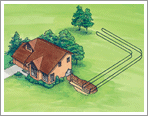Geothermal Systems
How Geothermal Systems Work
At the heart of a geothermal system are one or more ground source heat pumps, which operate in a manner similar to a common refrigerator. Unlike conventional heating systems that burn fossil fuels or use electricity to create heat, heat pumps simply move heat from one place to another.
The ground and lakes around us represent a vast reservoir of renewable thermal energy stored from the sun. This geothermal energy is estimated to exceed all other energy sources combined by more than two thousand times. At depths below 8 to 10 feet (2.5 to 3 meters), the earth's temperature remains at or near the average annual air temperature above.
Ground source heat pumps can provide both heating and cooling at efficiencies unachievable by other heating or cooling equipment. If you would like a more detailed explanation of how geothermal systems work, please feel free to contact us and we would be happy to answer any questions you may have.
Horizontal Loops
Horizontal loops are often considered when adequate land surface is available. Pipes are placed in trenches, in lengths that range from 100 to 400 feet.
Vertical Loops
Vertical loops are the ideal choice when available land surface is limited. Drilling equipment is used to bore small diameter holes from 75 to 300 feet deep.
Open Loops
Open loop systems are the fourth type and utilize ground water as a direct energy source. In ideal conditions, an open loop application can be the most economical type of geothermal system.
Pond Lakes
Pond (lake) loops are very economical to install when a body of water is available, because excavation costs are virtually eliminated. Coils of pipe are simply placed on the bottom of the pond or lake.
Geothermal Facts
Public awareness of geothermal systems is increasing rapidly. Polls show that more than 95% of all geothermal customers would recommend a geothermal system to a family member or friend.
The ground around us represents a vast reservoir of renewable thermal energy stored from the sun.
Geothermal systems collect this low grade thermal energy from the earth and concentrate it inside your home to provide heating through the geothermal heat pump. In the summer, the process is reversed and the heat pump provides air conditioning as it moves heat from your home and stores it back in the ground.
A professionally engineered geothermal system typically operates at a coefficient of performance of 3.0 -5.0, this represents efficiencies of 300% - 500%.
Geothermal systems eliminate the need for unsightly and noisy outdoor air conditioning units.
Installing a geothermal system in a typical residence has the same effect on Greenhouse Gas
Emissions reduced is the equivalent of removing 2 cars off the road or planting an acre of trees.
Geothermal systems reduce the need to extract, transport and burn fossil fuels.
Geothermal systems remove all risks of carbon monoxide from fossil fuel combustion.
Geothermal systems only utilize 17% - 25% of the total electrical consumption of the home.
Benefits of Owning a Geothermal System
Engineering Services
Application and Integration of Multiple Technologies
Evaluation of site specific solutions
Complete design-build services
Site specific geothermal evaluation and feasibility reports
Formation thermal conductivity tests
Desktop geological reviews
Residential Service Areas:
Vancouver & Vancouver Island
BC Interior
Commercial Service Areas:
Vancouver & Vancouver Island
BC Interior
United States





